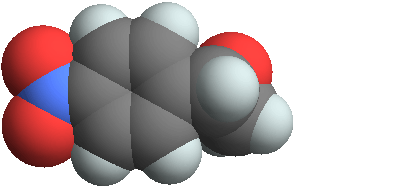Input interpretation

(s)-4-nitrostyrene oxide
Chemical names and formulas

formula | C_8H_7NO_3 name | (s)-4-nitrostyrene oxide IUPAC name | (2S)-2-(4-nitrophenyl)oxirane mass fractions | C (carbon) 58.2% | H (hydrogen) 4.27% | N (nitrogen) 8.48% | O (oxygen) 29.1%
Lewis structure

Draw the Lewis structure of (s)-4-nitrostyrene oxide. Start by drawing the overall structure of the molecule, ignoring potential double and triple bonds: Count the total valence electrons of the carbon (n_C, val = 4), hydrogen (n_H, val = 1), nitrogen (n_N, val = 5), and oxygen (n_O, val = 6) atoms: 8 n_C, val + 7 n_H, val + n_N, val + 3 n_O, val = 62 Calculate the number of electrons needed to completely fill the valence shells for carbon (n_C, full = 8), hydrogen (n_H, full = 2), nitrogen (n_N, full = 8), and oxygen (n_O, full = 8): 8 n_C, full + 7 n_H, full + n_N, full + 3 n_O, full = 110 Subtracting these two numbers shows that 110 - 62 = 48 bonding electrons are needed. Each bond has two electrons, so in addition to the 20 bonds already present in the diagram add 4 bonds. To minimize formal charge oxygen wants 2 bonds and carbon wants 4 bonds. Identify the atoms that want additional bonds and the number of electrons remaining on each atom: To fully fill its valence shell, nitrogen will donate one of its electrons, allowing it to form four bonds (the maximum number an element on period 2 can form). Fill in the 4 bonds by pairing electrons between adjacent highlighted atoms, noting the formal charges of the atoms. Double bonding nitrogen to the other highlighted oxygen atom would result in an equivalent molecule. The six atom ring is aromatic, so that the single and double bonds may be rearranged: Answer: | |
3D structure

3D structure
Basic properties

molar mass | 165.15 g/mol phase | solid (at STP)
Units

Hydrophobicity and permeability properties

predicted LogP hydrophobicity | 1.8 predicted LogS | -2.27
Basic drug properties

approval status | experimental | small molecule
Chemical identifiers
[O-] InChI identifier | InChI=1/C8H7NO3/c10-9(11)7-3-1-6(2-4-7)8-5-12-8/h1-4, 8H, 5H2/t8-/m1/s1 InChI key | YKIUTLHCSNCTDZ-MRVPVSSYBP](../image_source/870ab8bcf6ad4371ec533c3713bab048.png)
PubChem CID number | 1237169 PubChem SID number | 7890528 SMILES identifier | C1C(O1)C2=CC=C(C=C2)[N+](=O)[O-] InChI identifier | InChI=1/C8H7NO3/c10-9(11)7-3-1-6(2-4-7)8-5-12-8/h1-4, 8H, 5H2/t8-/m1/s1 InChI key | YKIUTLHCSNCTDZ-MRVPVSSYBP